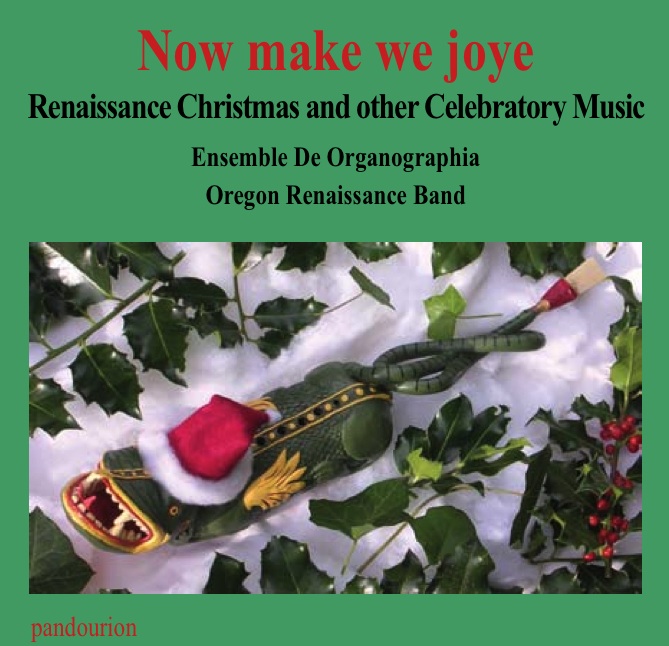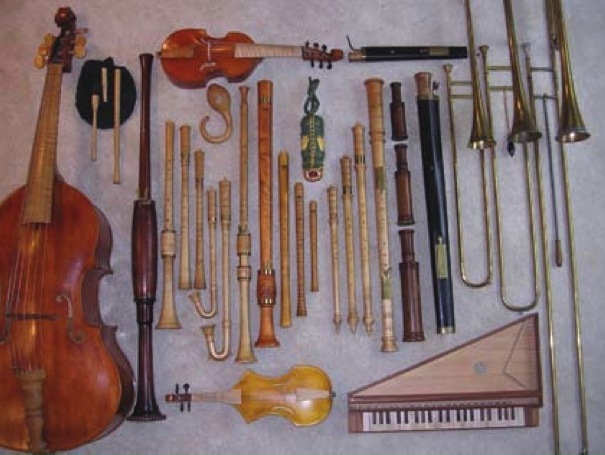


Ensemble De Organographia: Gayle Stuwe Neuman:
voice, viola da braccio (early violin), viola da gamba, sackbutt, recorder, cornamuse, ayacachtli (gourd rattle), claves, bell, tabor, tambourine; Philip Neuman: sackbutt, recorder, krummhorn, cornamuse, douçaine, Praetorius and Schnitzer schreierpfeiffen, rackett, tartold, spinettino, shawm, curtal, bagpipe, violone.
Oregon Renaissance Band directed by Gayle and Philip Neuman:
David Bryan: tenor sackbutt, Sharon Cheney: great bass rackett, Daphne Clifton: tenor recorder, Ben Fitch: tabor, Lori Fitch: soprano recorder, Polly Gibson: soprano recorder, Andrew Harris: tenor sackbutt, Kathy Langley: soprano recorder, Cindy Markham: tenor recorder, Kathryn Richer: bagpipe and tenor recorder.
The selections
1. Gaudete, from Piae Cantiones, 1582. Translation: “Rejoice, rejoice, Christ is born of Virgin Mary, rejoice. The time of grace has come for which we have beseeched, let us faithfully sing songs of joy. Rejoice... God is made man while nature marvels, the world is rejuvenated by Christ the King. Rejoice... Therefore let our congregation now sing praises at this time of cleansing, let it bless the Lord, salutations to our King. Rejoice...” voice; cant, alto, and tenor cornamusen, bass Praetorius schreierpfeife, 3 tenor sackbutts, bass and contrabass sackbutts, great bass rackett, 2 violas da braccio, 2 bass viols, violone, bell
2. Noe, noe, dies est laetitiae, Jean de Castro, 1588. cant and alto cornamusen, 2 tenor cornamusen, bass Praetorius schreierpfeife
3. Psallite unigenito, Michael Praetorius, 1609. sopranino and soprano Schnitzer schreierpfeiffen, alto and tenor shawms
4. Der Tag der ist so freudenreich, Michael Praetorius, 1610. alto recorder, viola da braccio
5. In dulci jubilo, Michael Praetorius, 1610. tenor recorder, viola da braccio
6. En natus est Emanuel, Michael Praetorius, 1609. spinettino
7. As it fell on a holie eve, Antony Holborne, 1599. 2 soprano recorders; alto, tenor, and bass recorders, tabor
8. From Virgin’s womb, William Byrd, 1589. voice, viola da braccio, 2 tenor viols, bass viol
9. Rejoice, rejoice, William Byrd, 1589. The chorus to “From Virgin’s womb.” 2 tenor recorders, 2 bass recorders
10. Vom Himmel hoch, Michael Praetorius, 1610. tenor recorder, viola da braccio
11. Heigh ho holiday, Antony Holborne, 1599. 2 soprano recorders; alto, tenor, and bass recorders, tambourine
12. Es ist ein Ros’ entsprungen, Michael Praetorius, 1609. viola da braccio, tenor and bass viols, tenor recorder
13. Nun freut euch, Michael Praetorius, 1609. tenor sackbutt, 2 bass sackbutts, contrabass sackbutt
14. Allon, gay bergeres, Guillaume Costeley, 1570. cant cornamuse, alto krummhorn, tenor krummhorn, bass douçaine
15. Guillaume se va chaufer, Anonymous, 1510 (formerly attributed to Josquin des Prez.) 2 cant cornamusen, bass viol, bass curtal
16. Es ist ein Schnee gefallen, Caspar Othmayr, 1549. tenor alt, bass, and great bass racketts, great bass tartold
17. Uns ist ein Kindelein, Michael Praetorius, 1609. spinettino
| track samples (30 - 60 sec.) |
| 7. As it fell on a holie eve | |
| 12. Es ist ein Ros’ entsprungen |
|
| 13. Nun freut euch | |
| 17. Uns ist ein Kindelein | |
| 22. Hanacpachap cussicuinin |


[...] Most selections are short – from 30 seconds to six minutes – but each one has a different flavor. That’s due primarily to the combinations of unique Renaissance-era instruments that are used, including those with terrific names, such as ayacachtli, tartold, racket, violone, shawm, sopranino Schnitzer schreierpfeiffen, krummhorns, doucaine, cornamusen, Praetorius schreierpfeife, curtal, spinettino, and, of course, the marvelous sackbut. All are assembled in a picture that accompanies the liner notes, and astoundingly enough, most were built by the Neumans.
The CD has a delightful mix of fast and slow tunes, and some feature the
silky smooth soprano of Gayle Neuman. Unless you are cozy with the
Renaissance repertoire, most of the tunes will be new to your ears;
however, you will certainly recognize a few in their original forms like
Michael Praetorius’s “Psallite unigenito,” “In dulci jubilo,” “En natus
est Emanuel” (played on the spinettino), “Es ist ein Ros’ entsprungen,”
and “Uns ist ein Kindelein, and Thoinot Arbeau’s peppy “Branle de
l’Official.” [...] |
| | |
|
Instruments built by Gayle and Philip Neuman: viola da braccio, cant, alto and tenor cornamusen, alto and bass curtals, bass Praetorius schreierpfeife, bass douçaine, alto and tenor krummhorns, sopranino and soprano Schnitzer schreierpfeiffen, alto shawm, tenor alt, bass and great bass racketts, contrabass sackbutt, great bass tartold, ayacachtli. Many thanks to Jacob Breedlove for the loan of the violone.  | |
| 18. Mervele noght Josep, Anonymous, c. 1500. treble, tenor, and bass viols 19. Now make we joye, Anonymous, c. 1500. alto and tenor recorders, viola da braccio 20. Ave Rex angelorum, Anonymous, c. 1450. treble viol, 2 tenor viols 21. Branle de l’Official, Thoinot Arbeau, 1589. 2 cylindrical bore single drone bagpipes, 3 soprano recorders, 3 tenor recorders, viola da braccio, 2 tenor sackbutts, bass sackbutt, great bass rackett, tabor 22. Hanacpachap cussicuinin, Anonymous, 1631. This is the first piece of polyphony published in the western hemisphere. Translation of the Quechua text: “O tree bearing fruit three times blessed, heaven’s delight, a thousand times we will praise you. O hope of humanity, attendant to the weak, hear our prayer. Hearken to our supplications, O pillar of ivory, Mother of God. Lovely iris, yellow and white, accept this song we offer you; assist us, reveal to us the fruit of your womb.” voice, 2 tenor sackbutts, bass sackbutt 23. Xicochi, xicochi conetzintle, Gaspar Fernandes, c. 1615. Translation of the Nahuatl text: “Sleep, sleep, my Child, verily the angels have come to call you, alleluia.” voice, alto recorder, viola da braccio, tenor and bass curtals, great bass rackett, ayacachtli (gourd rattle), claves 24. Dios itlaçonantzine, Don Hernando Franco, c. 1599. This is a chanzonetta by an Aztec composer who took the name of his mentor Hernando Franco. Translation of the Nahuatl text: “Cherished Mother of God, everlasting Virgin, we fervently implore you, intercede for us. In heaven you are in the company of your dearest Child, Jesus Christ. For you are there beside Him. In heaven you are in the company of your dearest Child, Jesus Christ.” voice, alto, tenor, and bass curtals |
Complete list of audio CD titles in the NPM catalogue
which feature or include the works of De Organographia:
French
Music from the 14th Century -- Ars Nova period realizations
on replicated period instruments.
Music of the
Ancient Greeks
Carnevale
-- Renaissance Italian Festival Music
Music of
the Ancient Sumerians, Egyptians and Greeks
One Horse
Open Sleigh -- 19th Century Christmas Music on original and
replicated instruments
Now
make we joye -- Renaissance Christmas and other Celebratory
Music
Everything is
Ragtime Now -- rare rags from the early 20th Century played
on period instruments, featuring Allan Martin
L'Autre
Jour -- harp music from the 18th & 19th Centuries,
featuring Laura Zaerr
|
go to: North Pacific Music Home Page
|